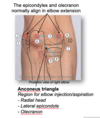Muscles Flashcards
(182 cards)
What muscles make up the anterior forearm 1st layer?
Where is there common attachement point?
Medial epicondyle
FCR
FCU
Palmaris Longus
Pronator Teres (inserts into midradial shaft)
What muscles make up the anterior forearm 2nd layer?
Where is it’s origin?
Medial epicondyle
FDS (to PIP)
What makes up the anterior forearm 3rd layer (deepest)
FDP (to DIP)
Pronator Quadratus
FPL
What makes up the posterior forarm superficial layer
(6 + 1)
What is the common attachment point of some of the muscles? Indicate this with a *
Brachioradialis (this is a flexor though)
*EDM
*ED
ECRL
*ECRB
*ECU
Anconeus
What makes up the posterior arm deep layer?
EPL (DIP)
EPB (MCP)
AbPL
EI (PIP)
Name the tendons found in the extensor compartments
with lateral being compartment one
1: AbPL & EPB
2: ECRL & ECRB
3: EPL
4: ED & EI
5: EDM
6: ECU
What compartment is De Quervians Tenosynovitis associated with?
Compartment 1- EPB, AbPL
What is the name of the tenosynovitius associated with compartment one?
De Quervians Tenosynovitis
What can happen to compartment 3?
EPL can wear on the Dorsal Radial Tubercle
What can happen to extensor compartment 6?
ECU can wear on the Ulnar styloid process
Where does the brachial artery bifurcate?
Cubital fossa
What makes up the cubital fossa?
What runs down the middle- why is this useful?
What is the contents?
Intercondylar line
Laterally: Brachioradialis
Medially: Pronator teres
2) Biceps tendon. Medial is median nerve and brachial artery
3) Really need, Beer to, Be at, My nicest
Radial artery
Biceps tendon
Brachial artery
Median nerve
Where does the Radial nerve run?
Off brachial plexus posteriorly
Through Triangular interval w/ Profunda Brachii
Down Spiral groove
Anterior to elbow
1cm lateral to biceps tendon
Then deep- Posterior Interosseous runs near radial neck
Where does the median nerve run?
Off brachial plexus laterally to axillary artery
Passes anterior to elbow
Medial to biceps tendon
Under plamaris longus
Through carpal tunnel
Describe the route of the ulnar artery
Comes of brachial plexus medially to axillary artery
Passes through cubital tunnel (near elbow)
Passes behind medial epicondyle
Runs under cover FCU
Lateral to pisiform
(NOT THOUGH CARPAL TUNNEL- through Guyons canal)
What runs medial to the biceps tendon?
Median nerve & Brachial artery
How would you expect a posterior hip dislocation to present?
Shortened, flexed and internally rotated
How would you expect an anterior hip dislocation to present?
ABducted & externally rotated
How would you expect a NOF to present?
LL shortened and externally rotated
What are the nerves off the lumbar plexus
Indecent Ian Gets Laid on Fridays Luckily
Iliohypogastric L1
Ilioinguinal L1
Genitofemoral L1&2
Lateral Cutaneus nerve of Thigh L2,3,4
Obturator L2-4
Femoral L2-4
Lumbosacral trunk L4-5
For pronation/ supination in relation to ulnar and radius, what bone moves?
Radius moves around the ulnar
What can an extracapsular # of the femur also be called?
Intertrochanteric
Describe how blood reaches the femoral head
- External Iliac
- Femoral (under inguinal ligament)
- Profunda Femoris
- Lateral/ Medial Circumflex
- Circumflex femoral/ Retinacular arteries
- Lateral/ Medial Circumflex
What is the Fascia Lata?
What does it form?
Fasica surrounding the compartments of the thigh
Forms the Ilio tibial tract (lateral thickening of facia lata)
- Muscle attachemnt Glut max
- Assist knee extension/ stability
- Saphenous vein runs superficial to fascia









